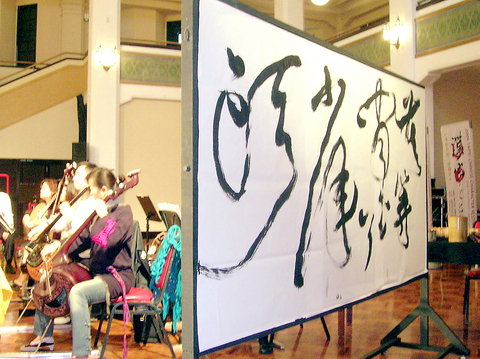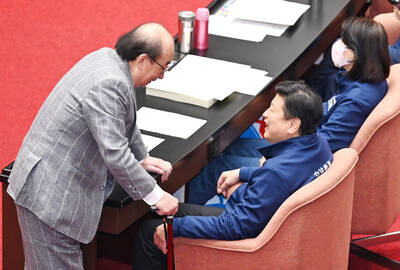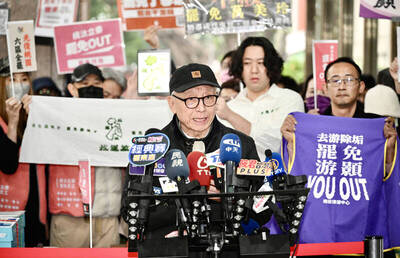Whether they make your heart beat faster or your head spin, Chinese characters are a powerful force to be reckoned with. Yet, as the world's most complicated writing system -- with its combination of pictograms, ideograms and phonetic signifiers -- Chinese script is under attack and has been for over a century.
The first-ever Taipei Chinese Character Festival is organized by Taipei city's Department of Cultural Affairs and examines the history and culture of as well as the present crises facing Chinese characters from academic, artistic and technological vantage points.

PHOTO: MEREDITH DODGE, TAIPEI TIMES
According to Liao Hsien-hao (
The month-long festival will kick off tomorrow night at
7:30pm with an outdoor multi-media concert in the plaza of the Ximending's Chungshan Auditorium. The concert will use a traditional Chinese orchestra for background music to which several master calligraphers will ink their different styles of characters on large sheets of paper.
The performance is designed to demonstrate how the act of writing a character can become like a dance in which each stroke has a different quality or emotion. However, unlike a dance, the performance produces a concrete work of art that allows viewers to reconstruct the calligrapher's movements as they examine each character. If this interactive performance can't show you how to appreciate the complex beauty of Chinese calligraphy, nothing can.
There will be plenty of opportunities for examining all kinds of Chinese characters at the festival's exhibition entitled Chinese Characters and Life. It will open on Dec. 31 at the National Museum of History. The exhibition will focus on four main topics.
One section will feature the five calligraphic scripts, each with its own historical and socio-cultural significance: the seal script (
Another section is devoted to the decorative function of characters, displaying a collection of everyday objects from tea utensils to weapons.
The calligraphic art section shows how the deceptively simple act of writing can become such a rich and highly developed art form, while the "Chinese character technology and modern art" section is sure to hold a few surprises. The exhibition will give visitors a chance to become acquainted with the historical and cultural aspects of something they see and use everyday. For example, did you know that there used to be a character set used only by women?
"Much of modern society considers Chinese characters to be a relic of the past," said Commissioner Liao at a press conference Tuesday. But the main point of the festival, he stressed, was not for Chinese culture to pat itself on the back for past glories.
The International Academic Conference on Chinese Characters and Globalization is planned for Jan. 28-30 at the National Library.
Liao said that the most important task for the conference was to identify and discuss the threats facing the Chinese writing system. Scholars and professionals from various fields will discuss the status of Chinese characters in the "Confucian sphere of influence," which extends throughout East and Southeast Asia. Although Japan is the only non-Chinese society that still uses Chinese characters in its writing system, both Korean and Vietnamese were written using Chinese (or Chinese-based) characters in the recent past.
What are the benefits or drawbacks of switching to Latin or phonetic scripts (as Korea and Vietnam) did or simplifying characters as China has? As the Chinese script that can be used to write very different languages, it has historically been a symbol of China's will to unite and rule "all under heaven." But in today's very different world, is the use of this ancient script still practical or meaningful?
Meanwhile, two competitions will give the public a chance to show off their love of Chinese characters, for better or worse.
The elementary school Chinese character competition will test youngsters' skill with idioms, variable pronunciations, etc. The first round will be held at various schools in Taipei on Dec. 29 and the final showdown will take place on Jan. 22 at Chungshan Auditorium. Call (02) 2371 0086 x 12 to sign up. The Chinese word-game software competition will award innovators with prizes of NT$100,000 for first place, NT$50,000 for second and NT$10,000 for third. Submissions are due Dec. 31 and prizes will be awarded on Jan. 22. Call (02) 2371 0086 x 9 to sign up or visit www.culture.gov.
Performance notes:
What: Taipei Chinese Character Festival Opening Concert: Flying Ink.
Where: Chungshan Auditorium Plaza, No 98 Yenping S Rd, Ximending MRT station exit 5
When: Tomorrow 7:30pm.
Details: Free admission. For more information on the festival, visit www.chinesecharacter.culture.gov.tw.

Taiwan doesn’t have a lot of railways, but its network has plenty of history. The government-owned entity that last year became the Taiwan Railway Corp (TRC) has been operating trains since 1891. During the 1895-1945 period of Japanese rule, the colonial government made huge investments in rail infrastructure. The northern port city of Keelung was connected to Kaohsiung in the south. New lines appeared in Pingtung, Yilan and the Hualien-Taitung region. Railway enthusiasts exploring Taiwan will find plenty to amuse themselves. Taipei will soon gain its second rail-themed museum. Elsewhere there’s a number of endearing branch lines and rolling-stock collections, some

Could Taiwan’s democracy be at risk? There is a lot of apocalyptic commentary right now suggesting that this is the case, but it is always a conspiracy by the other guys — our side is firmly on the side of protecting democracy and always has been, unlike them! The situation is nowhere near that bleak — yet. The concern is that the power struggle between the opposition Chinese Nationalist Party (KMT) and their now effectively pan-blue allies the Taiwan People’s Party (TPP) and the ruling Democratic Progressive Party (DPP) intensifies to the point where democratic functions start to break down. Both

The Democratic Progressive Party (DPP), Chinese Nationalist Party (KMT), and the country’s other political groups dare not offend religious groups, says Chen Lih-ming (陳立民), founder of the Taiwan Anti-Religion Alliance (台灣反宗教者聯盟). “It’s the same in other democracies, of course, but because political struggles in Taiwan are extraordinarily fierce, you’ll see candidates visiting several temples each day ahead of elections. That adds impetus to religion here,” says the retired college lecturer. In Japan’s most recent election, the Liberal Democratic Party lost many votes because of its ties to the Unification Church (“the Moonies”). Chen contrasts the progress made by anti-religion movements in

This was not supposed to be an election year. The local media is billing it as the “2025 great recall era” (2025大罷免時代) or the “2025 great recall wave” (2025大罷免潮), with many now just shortening it to “great recall.” As of this writing the number of campaigns that have submitted the requisite one percent of eligible voters signatures in legislative districts is 51 — 35 targeting Chinese Nationalist Party (KMT) caucus lawmakers and 16 targeting Democratic Progressive Party (DPP) lawmakers. The pan-green side has more as they started earlier. Many recall campaigns are billing themselves as “Winter Bluebirds” after the “Bluebird Action”